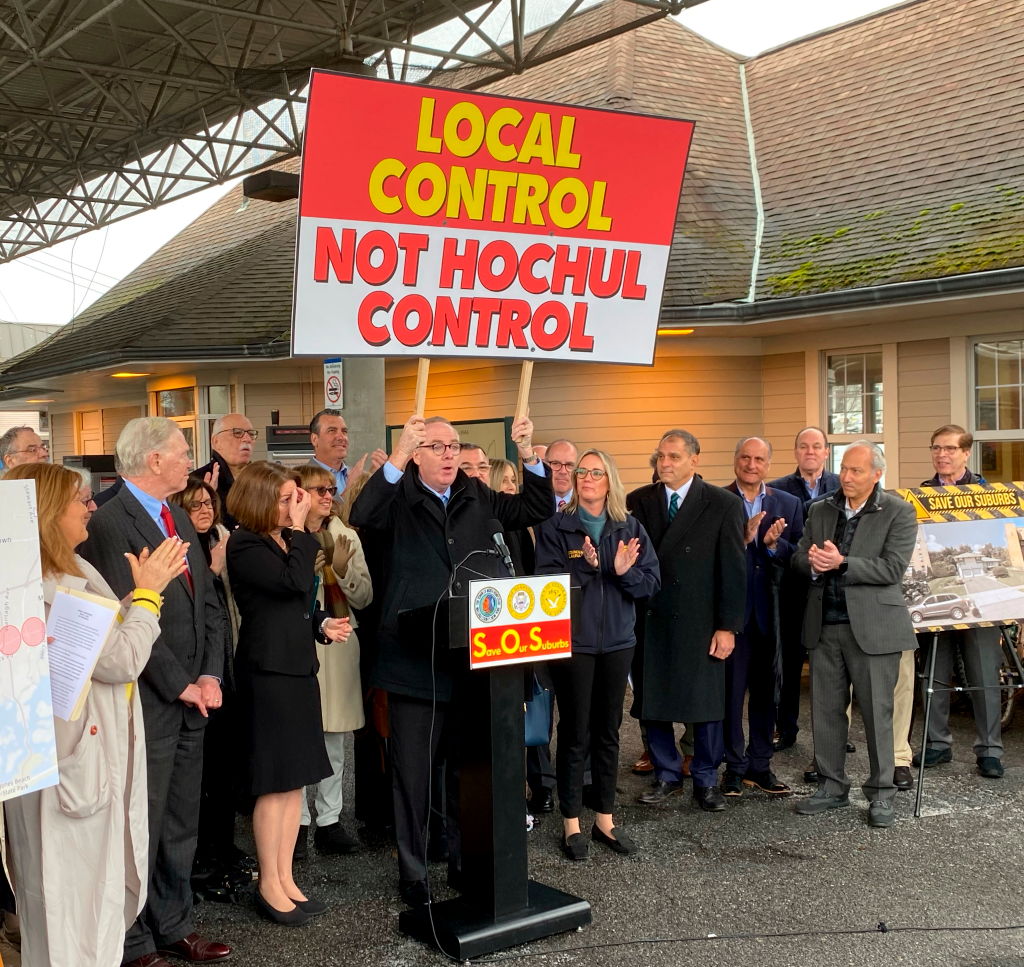The author is Mara Gay. The venue is the New York Times. And the enemy is the suburbanites who like their suburbs the way they are: “NIMBYs Threaten a Plan to Build More Suburban Housing,” reads the headline.
A proposal from New York Gov. Kathy Hochul, “a moderate Democrat, would simply bring the state’s housing policy into the 21st century, building crucially needed housing in the suburbs by slashing Jim Crow-era zoning laws.” Oh, that. By 21st-century policy, Gay means a mandate from Albany that the housing stock of every town in New York must grow by a certain percentage every three years–or face having local planning-and-zoning laws nullified by the state, which will then have a free hand to impose its own development agenda. “The purpose isn’t to attack the suburbs,” Gay writes, “but to help them grow, along with the rest of the state.”
Alert readers will see the problem in that last clause.
If you wanted to illustrate with only a few sentences what is wrong with New York Times-style progressivism, you could do worse than the above: the unsupported (and, in context, irrelevant) assertion that Gov. Hochul is a “moderate Democrat,” the cynical insinuation of racism, the insistence that Hochul’s so-called moderate plans are being held hostage by atavistic reactionaries who are opposed not to Hochul’s program but to the 21st century—and all of that crowned with a neon non sequitur: “to help them grow, along with the rest of the state.”
It would seem straightforward that New York state would need a growing housing stock to accommodate its growing population, but New York’s population is not growing—rather, the state has been, famously, losing population faster than any other U.S. state as a matter of absolute numbers and as a share of its population.
New York isn’t growing because it doesn’t have housing stock–there are nearly 1 million vacant properties in the state, a fair number of them long-term vacancies or abandoned homes. The problem is that New York has a lot of available housing in places no one wants to live, and, in New York City, thousands of housing units locked up by rent-control and rent-stabilization laws, with owners choosing to keep them off the market entirely rather than rent them at money-losing rates.
New York has many problems, but too many people wanting to live there is not one of them and has not been for some time. Maybe Tribeca has a housing-demand problem—Hochul is from Buffalo, which has been losing population since the Eisenhower administration and today has a population less than half of what it was at its peak. It is not unusual among New York cities: Syracuse has lost a third of its population from its peak, Rochester a third, Utica a third. Albany has lost a quarter. New York City has suffered recent shrinkage. The state itself is shedding population, losing 400,000 people from 2020-2022. That’s about the population of Yonkers, Albany, Utica, and Poughkeepsie combined–gone.
All that makes for a funny kind of housing crisis.
There are about 1 million unoccupied housing units in the state already, which is about what you would expect for a state that size; New York State’s vacancy rate is estimated by Lending Tree at an unremarkable 11.1 percent, right around the national average. None of that suggests a statewide housing-stock crisis. But there are complications: In New York City, tens of thousands of housing units have been taken off the market by landlords affected by rent-control and rent-stabilization rules—they simply won’t rent the places for the low rates demanded by politicians—and it has been estimated that there are four abandoned housing units in New York City for every homeless person or household. There are thousands and thousands of derelict and abandoned homes across the state, a problem that is so widespread that New York has a “zombie home” program to try to rehabilitate them.
Zoning is by nature a local issue, and, given the general incompetence of New York’s state government, it probably would be best to leave the suburbs to their own devices. Zoning laws matter a great deal, of course, but market demand can be a curiously powerful thing: In Texas (which gets a lot more California refugees than New York refugees, who go to Florida), there is a kind of interesting natural experiment that can be observed: Austin has pretty fussy and rigorous zoning laws, whereas Houston famously has practically no zoning laws at all. But the share of single-family homes in the housing mix is almost identical in those two cities, right around 50 percent. It is easy to build in Houston, and so builders build there—which is what you might expect, but you might not fully appreciate just how radical a difference that ends up being: Houston builds housing at three times the per capita rate of New York, according to M. Nolan Gray, author of Arbitrary Lines: How Zoning Broke the American City and How to Fix It. And that is working out pretty well, as Gray notes:
Far from the doomsday predictions made by the zoning pushers in bygone eras, unzoned Houston works just fine. Between 1970 and 2020, the city nearly doubled in population from 1.2 to 2.3 million, assuming the title of America’s fourth-largest city. Attracting a blend of working- and middle-class Americans and international migrants seeking opportunity, Houston is now our nation’s most diverse city. . . . This ongoing supernova of housing construction has helped to keep Houston one of the most affordable big cities in the U.S., offering new arrivals modest rents and accessible home prices even amid seemingly endless demand.
With apologies to the ladies and gentlemen of the New York Times, the evidence suggests that the most effective course of action is neither calling suburbanites racists nor centralizing zoning decisions at the state level but rather—mirabile dictu!—letting markets work. Rather than centralizing decision-making power in Albany, New York almost certainly would be far off with radical decentralization.
Repeat: New York does not have a statewide shortage of housing—what it has is a great deal of housing in places where people do not want to live. If you walked from my old neighborhood in the South Bronx to Mount Hope (and I don’t recommend that hike to everybody) you will see a lot of neat and tidy modest homes and a lot of boarded-up, vacant, and abandoned buildings. Many of these properties could be relatively easily rehabilitated, if people wanted to live in those neighborhoods and locate their most valuable family asset there. But they don’t, and the reason isn’t zoning laws. It’s the familiar stuff: crime, terrible schools, an obviously moribund mass-transit system.
Progressive misgovernance under Democratic leadership has wrecked New York communities from the Grand Concourse to Schiller Park—and, now, politicians of the very same stripe as the ones who wrecked those neighborhoods wants to wreck the unwrecked neighborhoods to make up for all of the housing stock in areas that have been rendered undesirable or positively unlivable. I myself am no great fan of zoning laws in general—I much prefer the Houston model—but New York’s problem isn’t that there are too many single-family homes in Rye and Scarsdale. New York is a product of bad policy badly conceived and badly executed by such mediocrities as Govs. Hochul and Andrew Cuomo and the sub-mediocrities who dominate its legislature. You aren’t going to engineer your way out of that by ordering suburbs to permit more apartment buildings.
Where they need more apartment buildings is in Florida—to house all the New Yorkers moving there.
Correction: A previous version of this story misspelled Mara Gay’s name.







Please note that we at The Dispatch hold ourselves, our work, and our commenters to a higher standard than other places on the internet. We welcome comments that foster genuine debate or discussion—including comments critical of us or our work—but responses that include ad hominem attacks on fellow Dispatch members or are intended to stoke fear and anger may be moderated.
With your membership, you only have the ability to comment on The Morning Dispatch articles. Consider upgrading to join the conversation everywhere.